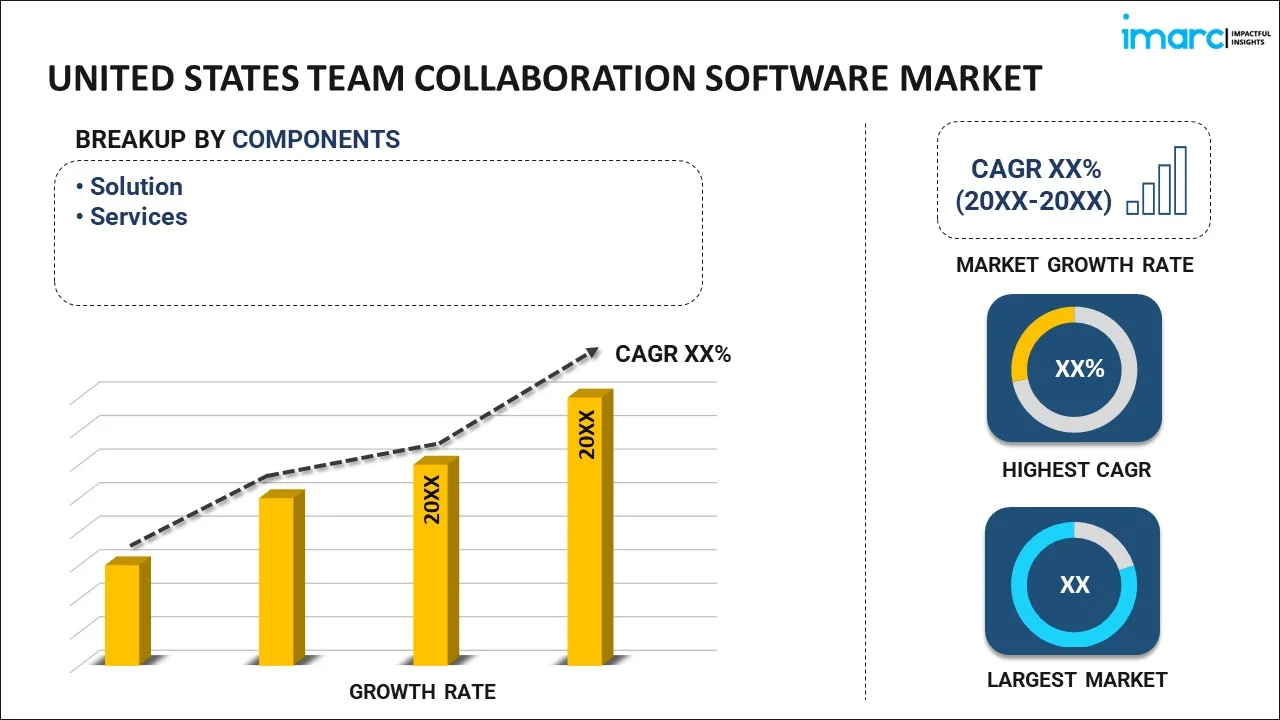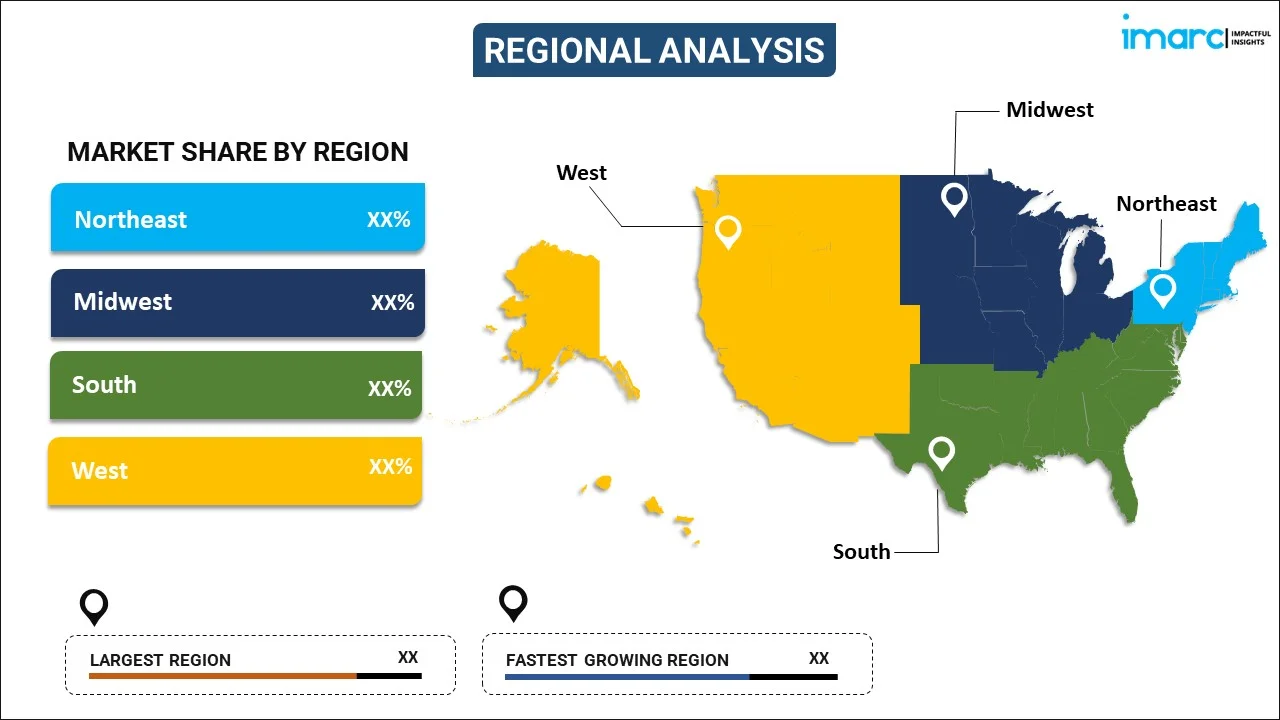
United States Team Collaboration Software Market Report by Components (Solution, Services), Software Type (Conferencing, Communication and Co-Ordination), Deployment (On-Premises, Cloud-based), Industry Vertical (BFSI, Manufacturing, Healthcare, IT and Telecommunications, Retail and E-commerce, Government and Defense, Media and Entertainment, Education, and Others), and Region 2024-2032
Market Overview:
United States team collaboration software market size is projected to exhibit a growth rate (CAGR) of 9.60% during 2024-2032. The increasing adoption of cloud computing services, which allow for the scalability, flexibility, and accessibility of team collaboration tools, is driving the market.
|
Report Attribute
|
Key Statistics
|
|---|---|
|
Base Year
|
2023 |
|
Forecast Years
|
2024-2032
|
|
Historical Years
|
2018-2023
|
| Market Growth Rate (2024-2032) | 9.60% |
Team collaboration software refers to digital tools and platforms designed to enhance communication, coordination, and productivity among members of a team or organization. These applications facilitate real-time interaction, document sharing, task management, and project collaboration, fostering seamless teamwork regardless of physical locations. Features often include instant messaging, video conferencing, file sharing, and project tracking, enabling teams to collaborate efficiently and stay organized. Popular examples include Slack, Microsoft Teams, and Asana. Team collaboration software promotes transparency, reduces reliance on email, and streamlines workflows by centralizing communication and project-related information. This technology is crucial in modern work environments, especially with the rise of remote and distributed teams, as it helps bridge geographical gaps and encourages a more connected and productive workforce.
United States Team Collaboration Software Market Trends:
The team collaboration software market in the United States has witnessed unprecedented growth in recent years, primarily due to the increasing trend of remote work. Consequently, organizations are actively seeking innovative solutions to enhance communication and productivity among their dispersed teams. In this context, the surge in demand for real-time collaboration tools can be attributed to the need for seamless connectivity across geographically diverse workforces. Moreover, as businesses recognize the value of fostering a collaborative culture, the market for team collaboration software is driven by the growing emphasis on teamwork and collective problem-solving. Furthermore, the integration of advanced features such as video conferencing, file sharing, and project management within a unified platform has significantly propelled the adoption of collaboration tools. This integration not only streamlines communication but also contributes to workflow efficiency, a critical factor in the contemporary business landscape. Additionally, the rising prevalence of flexible work arrangements and the need for instant communication, which have amplified the importance of these software solutions, is expected to drive the team collaboration software market in the United States during the forecast period.
United States Team Collaboration Software Market Segmentation:
IMARC Group provides an analysis of the key trends in each segment of the market, along with forecasts at the country level for 2024-2032. Our report has categorized the market based on components, software type, deployment, and industry vertical.
Components Insights:

- Solution
- Services
The report has provided a detailed breakup and analysis of the market based on the components. This includes solution and services.
Software Type Insights:
- Conferencing
- Communication and Co-Ordination
A detailed breakup and analysis of the market based on software type have also been provided in the report. This includes conferencing and communication and co-ordination.
Deployment Insights:
- On-Premises
- Cloud-based
The report has provided a detailed breakup and analysis of the market based on the deployment. This includes on-premises and cloud-based.
Industry Vertical Insights:
- BFSI
- Manufacturing
- Healthcare
- IT and Telecommunications
- Retail and E-commerce
- Government and Defense
- Media and Entertainment
- Education
- Others
A detailed breakup and analysis of the market based on industry verticals have also been provided in the report. This includes BFSI, manufacturing, healthcare, IT and telecommunications, retail and e-commerce, government and defense, media and entertainment, education, and others.
Regional Insights:

- Northeast
- Midwest
- South
- West
The report has also provided a comprehensive analysis of all the major regional markets, which include the Northeast, Midwest, South, and West.
Competitive Landscape:
The market research report has also provided a comprehensive analysis of the competitive landscape in the market. Competitive analysis such as market structure, key player positioning, top winning strategies, competitive dashboard, and company evaluation quadrant has been covered in the report. Also, detailed profiles of all major companies have been provided.
United States Team Collaboration Software Market Report Coverage:
| Report Features | Details |
|---|---|
| Base Year of the Analysis | 2023 |
| Historical Period | 2018-2023 |
| Forecast Period | 2024-2032 |
| Units | Million US$ |
| Scope of the Report | Exploration of Historical and Forecast Trends, Industry Catalysts and Challenges, Segment-Wise Historical and Predictive Market Assessment:
|
| Components Covered | Solution, Services |
| Software Types Covered | Conferencing, Communication and Co-Ordination |
| Deployments Covered | On-Premises, Cloud-based |
| Industry Verticals Covered | BFSI, Manufacturing, Healthcare, IT and Telecommunications, Retail and E-commerce, Government and Defense, Media and Entertainment, Education, Others |
| Regions Covered | Northeast, Midwest, South, West |
| Customization Scope | 10% Free Customization |
| Report Price and Purchase Option | Single User License: US$ 3699 Five User License: US$ 4699 Corporate License: US$ 5699 |
| Post-Sale Analyst Support | 10-12 Weeks |
| Delivery Format | PDF and Excel through Email (We can also provide the editable version of the report in PPT/Word format on special request) |
Key Questions Answered in This Report:
- How has the United States team collaboration software market performed so far and how will it perform in the coming years?
- What has been the impact of COVID-19 on the United States team collaboration software market?
- What is the breakup of the United States team collaboration software market on the basis of components?
- What is the breakup of the United States team collaboration software market on the basis of software type?
- What is the breakup of the United States team collaboration software market on the basis of deployment?
- What is the breakup of the United States team collaboration software market on the basis of industry vertical?
- What are the various stages in the value chain of the United States team collaboration software market?
- What are the key driving factors and challenges in the United States team collaboration software?
- What is the structure of the United States team collaboration software market and who are the key players?
- What is the degree of competition in the United States team collaboration software market?
Key Benefits for Stakeholders:
- IMARC’s industry report offers a comprehensive quantitative analysis of various market segments, historical and current market trends, market forecasts, and dynamics of the United States team collaboration software market from 2018-2032.
- The research report provides the latest information on the market drivers, challenges, and opportunities in the United States team collaboration software market.
- Porter's five forces analysis assist stakeholders in assessing the impact of new entrants, competitive rivalry, supplier power, buyer power, and the threat of substitution. It helps stakeholders to analyze the level of competition within the United States team collaboration software industry and its attractiveness.
- Competitive landscape allows stakeholders to understand their competitive environment and provides an insight into the current positions of key players in the market.
Need more help?
- Speak to our experienced analysts for insights on the current market scenarios.
- Include additional segments and countries to customize the report as per your requirement.
- Gain an unparalleled competitive advantage in your domain by understanding how to utilize the report and positively impacting your operations and revenue.
- For further assistance, please connect with our analysts.
 Inquire Before Buying
Inquire Before Buying
 Speak to an Analyst
Speak to an Analyst
 Request Brochure
Request Brochure
 Request Customization
Request Customization




.webp)




.webp)












